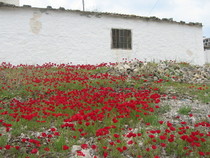Spring Flora
April Waysides and May Day Wreaths
Well, of all the months to get your gardening clothes on and trowels in hand, this is the one- April – the busiest gardening month in the Greek calendar. There is such a vast amount of work to do – what with tidying up after the winter and making sure that everything is just right for the long and incredibly dry summer. Not to mention any seeds that may still need to be sewn and weeds that may need to be weeded!
The flowers are also at their busiest in April, with a huge amount of blooming going on, therefore ensuring that waysides, hillsides and scrubland certainly are at their prettiest. March asphodels are withering, but all kinds of other bright and colourful flora are popping up all around, including the Corn Poppy! This is a beautiful sight – fields of scarlet poppies, swaying in the spring breeze or as a mass of red behind an old whitewashed wall, which makes a warm and contrasting sight. Slightly less common, is the Long-Headed Poppy, which tends to come out a little later and is more pink than red. Take care though, one brush of the hand is enough to see their pretty petals fall to the ground!
Another spectacular sight is the simple – but very delightful – Rock Rose (also known as Cistus). Seen in abundance at this time of the year, across meadow land, pine forest, hill and mountain side – the purple grey-leaved Cistus and the white Gum Sistus and Sage-leaved Sistus, are bushy evergreen shrubs that are looked upon as weeds in Greece. Hardy and long flowering, they survive well into early summer. Their orangey-yellow centres give a great look of depth to their rather papery petals and their thyme-scented perfume is truly Greek. The Gum Cistus is grown for its resin, ladanum, which is used as a base for various medications and some perfumes.
Out and about you may catch sight of locals collecting great bunches of chamomile flowers. This is for chamomile tea, which is not only popular for its taste, but also as a cure for all ails! From tummy aches, sore eyes and wounds – it's a favourite Greek remedy...It is also used for a more aesthetically pleasing pastime – that of the great May 1st 'stefani' (wreath). Being a national holiday, the custom is to get out into the countryside and collect spring flowers for the wreath and to hang it on the door until 24th June. (the feast day of St. John the Baptist). It is an extremely sociable event as friends will often go back to each other's houses to make them. School children will also make a wreath to take home to their parents, so front and back doors will always find themselves adorned! This national holiday really signifies the end of bad weather and the promise of better months ahead, and there is a general feeling of excitement and well being on this day.
Certainly well before May, but looking pretty good during this month, is the large bushy, shrubby perennial, Marguerite (Chrysanthemum frutescuns) or Paris Daisy, as it's known. This dominates the countryside, along with its relative the Crown Daisy (Chrysantheemum coronaium) which is also one of the main flowers used for May day wreaths. The Greeks fondly name all these daisy-type flowers as Margaríta.
Even though by the middle of May most of the flowers are dying away, there is the welcome appearance of various summer vegetables, including all the ingredients of the tasty Greek dish called 'briam' (baked summer vegetables). These include courgettes, aubergines, peppers and tomatoes – a sure sign that summer is on the way.
APRIL WAYSIDES AND MAY DAY WREATHS: COPYRIGHT LUCY PARASKEVA









